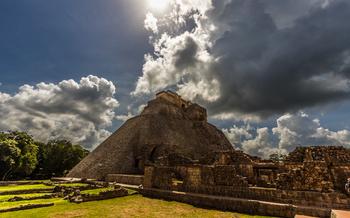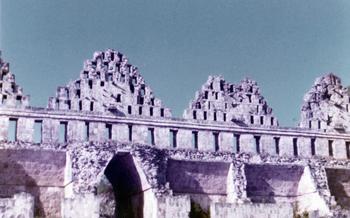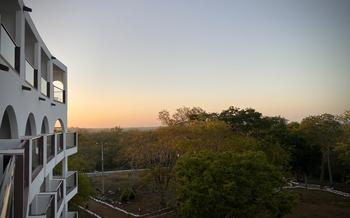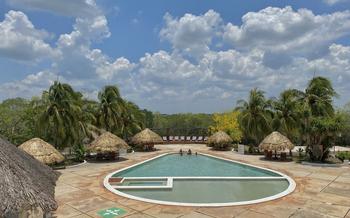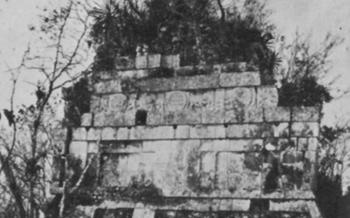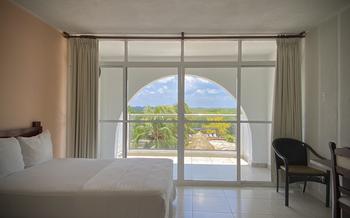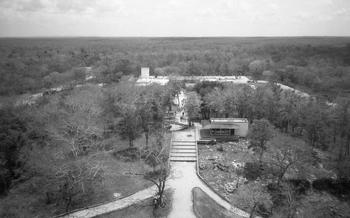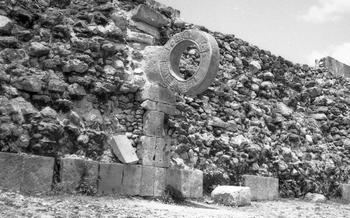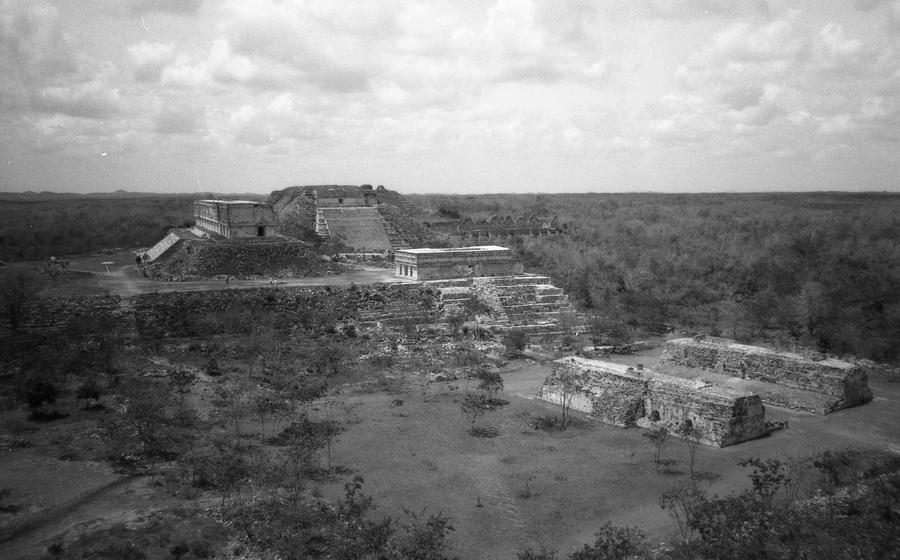
Calkini Town
- Uxmal: A Journey to the Past
- Exploring the Grand Plaza
- The Pyramid of the Magician: A Symbol of Power
- Ball Courts: A Glimpse into Mayan Sports
- The Nunnery Quadrangle: A Place of Mystery
- The Palace of the Governors: A Symbol of Mayan Leadership
- The House of the Turtles: A Unique Architectural Gem
- The Temple of the Birds: A Sanctuary for Avian Deities
- The Cenote of Uxmal: A Natural Oasis
- The Choco-Story Museum: A Sweet Adventure
- The Light and Sound Show: A Multimedia Spectacle
- Calkiní Town: A Colorful Colonial Gem
- Mercado Municipal de Calkiní: A Culinary Adventure
- Insider Tip: Uxmal at Night
Uxmal: A Journey to the Past
In the heart of the Puuc region, amidst the lush Yucatán Peninsula, lies the ancient Maya city of Uxmal. This marvel of pre-Columbian architecture transports visitors back in time to the height of Maya civilization. Founded around the 6th century AD, Uxmal flourished as a prominent political and cultural center until its decline in the 10th century. Its well-preserved ruins, intricate carvings, and grand plazas offer a glimpse into the sophisticated society that once thrived here.
Located approximately 62 miles south of Mérida, Uxmal is easily accessible by car or guided tour. The city's proximity to other Maya sites, such as Chichén Itzá and Kabah, makes it an ideal destination for history and culture enthusiasts. As you approach Uxmal, the towering pyramids and grand structures emerge from the jungle canopy, promising an unforgettable journey into the past.
Exploring the Grand Plaza
The central plaza, also known as the Great Plaza, is the heart of Uxmal and played a pivotal role in Mayan life. Surrounded by grand structures, including the Governor's Palace, the Pyramid of the Magician, and the Temple of the Turtles, this vast open space served as a stage for religious ceremonies, public gatherings, and markets.
The Pyramid of the Magician, the plaza's most striking feature, dominates the skyline with its imposing height and intricate carvings. Dedicated to the rain god Chac, this temple showcases Mayan architectural prowess and is a testament to their astronomical knowledge.
The Governor's Palace, located on the plaza's north side, is another magnificent structure that once housed the city's rulers. Its elaborate facades, adorned with intricate sculptures and colorful paintings, provide a glimpse into the opulence and grandeur of Mayan life.
To fully appreciate the intricate details and symbolism of these structures, take your time exploring the plaza. Capture the perfect shot of the Pyramid of the Magician, framed by the surrounding buildings, or wander through the Temple of the Turtles, marveling at its unique roof combs. Avoid the crowds by arriving early in the morning or late in the afternoon, allowing you to soak in the tranquility of this ancient space.
The Pyramid of the Magician: A Symbol of Power
The Pyramid of the Magician, also known as the Great Pyramid, stands as a testament to the architectural prowess and spiritual beliefs of the ancient Maya. Towering over the Grand Plaza, this massive structure is a symbol of power and prestige, embodying the city's connection to the divine realm.
Its construction involved a unique technique known as corbel vaulting, where successive layers of stone were stacked without the use of mortar. This innovative method allowed the Maya to create impressive chambers and passageways within the pyramid, which were likely used for religious rituals and ceremonies.
Legends abound about the pyramid's construction, adding to its mystique. One tale speaks of a dwarf-like magician who, with the help of a beautiful princess, completed the pyramid in a single night. Another legend tells of a hidden treasure buried within the pyramid, guarded by a fierce serpent.
Climbing the steep steps of the pyramid is a must-do experience, offering breathtaking panoramic views of the surrounding jungle and the ancient city below. As you reach the summit, you'll be rewarded with a sense of awe and wonder, standing where the Maya once performed their sacred rituals and gazed upon the vast expanse of their empire.
Ball Courts: A Glimpse into Mayan Sports
The ancient Maya held a profound reverence for the ball game, known as pok-ta-pok. It was more than just a sport; it held deep cultural and religious significance, often associated with fertility, warfare, and the cosmos. Uxmal boasts two impressive ball courts, each showcasing the Maya's architectural prowess and love for the game.
The courts are situated on either side of the Grand Plaza, mirroring each other in their design and dimensions. They consist of two long, parallel walls with sloped sides, creating a narrow playing field. The walls are adorned with intricate carvings, depicting scenes of players, rulers, and deities. These elaborate embellishments suggest that the ball courts were not just sporting arenas but also sacred spaces where rituals and ceremonies took place.
The rules of the game remain shrouded in mystery, but scholars believe it involved hitting a solid rubber ball with the hips, elbows, or knees, aiming to keep it in play and score points by striking specific targets on the walls. The game was highly competitive, with teams representing different cities or social groups. Victories were celebrated with great fanfare, while defeats could have serious consequences, including the sacrifice of the losing team's captain.
Exploring the ball courts in Uxmal is a captivating experience that transports visitors back to a time when the Maya civilization flourished. The courts stand as testaments to the Maya's athleticism, artistry, and deep spiritual connection to the game of pok-ta-pok.
The Nunnery Quadrangle: A Place of Mystery
The Nunnery Quadrangle, despite its name, was likely not a residence for nuns. Instead, it served various purposes throughout Uxmal's history. While its exact function remains a mystery, theories suggest it may have been a palace, a school for scribes, or even a marketplace.
The quadrangle's architectural features are as intriguing as its history. Its four sides enclose a central courtyard, surrounded by 74 rooms arranged in two stories. The facades are adorned with intricate carvings, depicting geometric patterns, human figures, and mythical creatures. The most striking feature is the row of 56 columns supporting the upper floor, each adorned with unique designs.
Legends and theories abound regarding the Nunnery Quadrangle's name and purpose. One legend tells of a beautiful princess who was forced to live in the quadrangle as punishment for her forbidden love. Another theory suggests that it was a place where women were trained in the arts of weaving and embroidery.
To fully appreciate the Nunnery Quadrangle's mystery and beauty, take your time exploring its many rooms and courtyards. Imagine the lives that unfolded within these walls, and let the stories and legends transport you back to Uxmal's glorious past.
The Palace of the Governors: A Symbol of Mayan Leadership
The Palace of the Governors stands as a testament to the power and prestige of the Mayan rulers. Constructed in the 10th century, this magnificent palace served as the administrative and political center of Uxmal. Its impressive size and intricate architecture reflect the wealth and influence of the Mayan elite.
The palace is composed of a series of interconnected rooms and courtyards, each serving a specific function. The main facade is adorned with elaborate carvings depicting scenes of Mayan mythology and history. These carvings provide valuable insights into the beliefs and customs of the ancient Maya.
Inside, the palace boasts a range of well-preserved rooms, including audience chambers, living quarters, and storage areas. The walls are adorned with colorful murals and bas-relief sculptures, showcasing the artistic and technical prowess of the Mayan artisans.
The Palace of the Governors is not only a symbol of Mayan leadership but also a testament to their ingenuity and creativity. It offers a glimpse into the daily life of the Mayan rulers and provides a fascinating glimpse into the grandeur of their civilization.
The House of the Turtles: A Unique Architectural Gem
Amidst the impressive structures of Uxmal, the House of the Turtles stands out for its distinctive design and intriguing symbolism. This two-story building derives its name from the turtle-shaped roof combs that adorn its summit, symbolizing fertility and longevity in Mayan culture.
The intricately carved facades of the House of the Turtles showcase a mesmerizing array of geometric patterns, animal motifs, and human figures. Scholars believe that these elaborate decorations held religious and political significance, narrating stories from Mayan mythology and honoring important deities.
The exact purpose of the House of the Turtles remains a subject of debate among archaeologists. Some suggest that it served as a residence for high-ranking officials or priests, while others propose that it was a ceremonial center or a place of astronomical observation. Regardless of its precise function, the House of the Turtles undoubtedly holds a significant place within the architectural legacy of Uxmal.
When exploring this unique building, take the time to admire the intricate carvings and sculptures that adorn its walls and doorways. Each element contributes to the overall narrative, providing a glimpse into the beliefs and practices of the ancient Maya.
The Temple of the Birds: A Sanctuary for Avian Deities
Historical and Religious Significance:
The Temple of the Birds, known as the Templo de los Pájaros in Spanish, holds a significant place in Mayan religious beliefs. Dedicated to the revered Maya bird god Itzamna, this temple served as a sanctuary for avian deities and was a prominent site for rituals and ceremonies honoring these divine beings. Itzamna, often associated with the heavens, knowledge, and creation, was deeply revered by the Maya, and the temple was a testament to their devotion to this celestial deity.
Architectural Features and Symbolism:
The Temple of the Birds showcases remarkable architectural features that reflect its avian associations. Its facade is adorned with intricate carvings depicting various bird species, including toucans, parrots, and eagles. These carvings not only add to the temple's aesthetic appeal but also serve as symbolic representations of the divine presence within. The interior of the temple features several chambers, each with unique decorative elements related to birds and avian symbolism.
Legends and Myths:
The Temple of the Birds is shrouded in a rich tapestry of legends and myths that further enhance its allure. One popular legend tells the tale of a great bird that once nested atop the temple, bringing good fortune and protection to the Maya people. Another myth speaks of a hidden chamber within the temple that contains a treasure trove of sacred artifacts and knowledge, guarded by the spirits of the avian deities. These legends add a layer of enchantment to the temple and contribute to its mystique.
Tips for an Enriching Experience:
Visit During Birdwatching Season: To fully immerse yourself in the avian ambiance of the temple, plan your visit during the region's birdwatching season, typically from November to April. This period offers an opportunity to spot a variety of bird species that frequent the area, adding to the temple's natural charm.
Seek Expert Guidance: Consider hiring a knowledgeable guide who can provide insights into the temple's history, symbolism, and legends. They can help you decipher the intricate carvings and explain the cultural significance of the avian motifs.
Capture the Moment: The Temple of the Birds presents numerous photo opportunities. Capture the intricate carvings, the serene atmosphere, and the surrounding natural beauty. Remember to respect the sanctity of the site and avoid using flash photography.
The Cenote of Uxmal: A Natural Oasis
In the heart of Uxmal, nestled amidst the ancient ruins, lies a natural wonder that holds a special place in Maya history and spirituality: the Cenote of Uxmal. This subterranean pool, known as a cenote, was a vital water source for the Maya, providing them with a reliable supply of fresh water during both wet and dry seasons.
The Cenote of Uxmal is a sinkhole formed by the collapse of limestone bedrock, creating a deep, circular well that reaches a depth of approximately 20 meters. Its crystal-clear waters, fed by underground aquifers, shimmer in shades of blue and green, inviting visitors to take a refreshing dip.
The Maya held the cenotes in high regard, considering them sacred portals to the underworld. They believed that the cenotes were inhabited by spirits and deities, and that offerings made into the water would reach these supernatural beings. Archaeological excavations have uncovered numerous artifacts, including pottery, jewelry, and human remains, that were deposited into the Cenote of Uxmal as offerings.
Today, visitors can still experience the magic of the Cenote of Uxmal. A staircase carved into the rock leads down to a platform where visitors can admire the cenote's beauty and take a dip in its refreshing waters. The cenote is surrounded by lush vegetation, creating a tranquil and serene atmosphere.
Remember to swim with caution and follow safety guidelines, as the cenote can be deep and there may be submerged rocks or uneven surfaces. Snorkeling or diving in the cenote is not permitted to preserve its delicate ecosystem and cultural significance.
The Choco-Story Museum: A Sweet Adventure
Immerse yourself in the captivating world of chocolate at the Choco-Story Museum, a unique attraction located in Uxmal. Discover the rich history of chocolate in Mayan culture, where it was revered as a divine gift and used as a currency. Interactive exhibits and displays take you on a journey from the humble cacao bean to the delectable chocolate bar.
Learn about the ancient Mayan techniques of chocolate making and marvel at the intricate tools and machinery used in the process. Engage your senses as you taste and sample different types of chocolate, including traditional Mayan recipes that have been passed down through generations.
The Choco-Story Museum is a delightful experience for chocolate enthusiasts, history buffs, and anyone with a sweet tooth. Indulge in the rich flavors and aromas of chocolate while gaining insights into its cultural significance and its role in shaping the Mayan civilization.
The Light and Sound Show: A Multimedia Spectacle
As night falls upon Uxmal, the ancient city comes alive with a dazzling spectacle of light and sound. This multimedia extravaganza takes visitors on a journey through the history and culture of the Maya, using state-of-the-art technology to bring the ruins to life.
The show begins with a mesmerizing display of lights that illuminate the majestic Pyramid of the Magician, casting intricate shadows that dance across its surface. As the story unfolds, the audience is transported back in time, witnessing the rise and fall of the Maya civilization and the legends that have shaped its legacy.
The show's immersive soundscape enhances the visual experience, with haunting melodies and dramatic sound effects that transport the audience to the heart of the ancient Maya world. The voices of Maya storytellers and historians guide the audience through the narrative, sharing tales of bravery, sacrifice, and the enduring spirit of the Maya people.
Practical Tips:
- Show times vary throughout the year, so check the official website or with local tour operators for the most up-to-date schedule.
- Ticket prices range from 250 to 350 pesos (approximately $13 to $18) and can be purchased at the entrance or in advance online.
- For the best views, arrive early and secure a spot in the center of the seating area.
- Bring a camera to capture the stunning visuals, but be mindful of using flash photography, which can disrupt the show.
- Dress comfortably and bring a light jacket or sweater, as the evenings can be cool, especially during the winter months.
Calkiní Town: A Colorful Colonial Gem
Calkiní, a former hacienda town located just a short distance from Uxmal, offers a delightful blend of colonial charm, vibrant culture, and culinary delights. Step into the town's historic center, and you'll be greeted by colorful colonial-era buildings, intricately adorned with stucco facades and vibrant street art. Admire the town's central plaza, adorned with a beautifully preserved kiosk and surrounded by charming cafes and shops.
Calkiní is renowned for its vibrant cultural traditions, including traditional dance performances, colorful festivals, and lively markets. Immerse yourself in the town's rich culinary heritage by sampling regional delicacies such as cochinita pibil, panuchos, and salbutes. Engage with the friendly locals, who are always eager to share stories and insights into their way of life.
Stroll along the picturesque streets, adorned with colorful murals depicting Mayan legends and historical events. Don't miss the opportunity to visit the Iglesia de San Luis Obispo, a stunning 18th-century church that showcases the town's architectural heritage. As the sun begins to set, Calkiní transforms into a magical place, with the warm glow of the evening light illuminating the town's colonial facades.
Mercado Municipal de Calkiní: A Culinary Adventure
The Mercado Municipal de Calkiní is a bustling hub of activity that offers a glimpse into the daily lives of locals and the vibrant culinary traditions of the Yucatan Peninsula. As you wander through the market, you'll be greeted by a symphony of colors, aromas, and friendly faces.
Stalls overflow with fresh produce, including tropical fruits like mangoes, pineapples, and papayas, as well as an array of vegetables, herbs, and spices. Here, you can find all the ingredients you need to prepare a delicious Yucatecan feast. But beyond the fresh produce, the market is also a treasure trove of traditional Mayan dishes, handmade crafts, and unique souvenirs.
One of the highlights of the market is the vast selection of street food stalls, where you can sample local delicacies such as panuchos, salbutes, and cochinita pibil. These traditional Mayan dishes, made with fresh, local ingredients, are a testament to the region's rich culinary heritage.
As you navigate the market, be sure to engage with the friendly vendors who are more than happy to share their knowledge about the local products and cuisine. Don't be afraid to bargain for the best prices and ask for recommendations on what to try.
The Mercado Municipal de Calkiní is a must-visit for anyone interested in experiencing the authentic flavors and culture of the Yucatan Peninsula. Immerse yourself in the vibrant atmosphere, sample the delicious food, and take home unique souvenirs that will remind you of your time in this special place.
Insider Tip: Uxmal at Night
Beyond the daytime's bustling crowds, Uxmal reveals a different charm under the cloak of darkness. Special night tours offer a unique opportunity to experience the ancient city in a tranquil and mystical ambiance. As the sun sets, the ruins are bathed in a warm glow, casting long shadows that add an aura of mystery and intrigue.
Imagine standing before the majestic Pyramid of the Magician, its silhouette sharply defined against the starlit sky. The silence is broken only by the gentle chirping of crickets and the distant hooting of owls, creating a surreal atmosphere that transports you back in time.
Night photography enthusiasts will find Uxmal a dream come true. The lack of ambient light allows for long exposure shots, capturing the ruins in all their grandeur without the distraction of daytime shadows. Experiment with different shutter speeds and compositions to create stunning images that showcase the beauty of Uxmal under the stars.
For a truly immersive experience, consider signing up for a guided night tour. Knowledgeable guides will share stories and legends about Uxmal's past, bringing the ancient city to life in a whole new light. Whether you're a history buff, a photographer, or simply someone seeking a unique travel experience, a night visit to Uxmal is a must.

